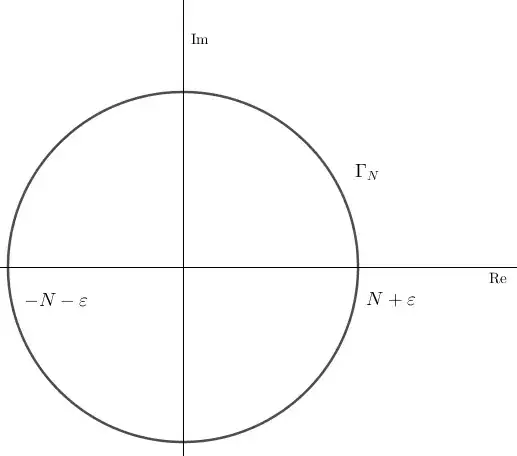I've got a complex function:
$$f(z)=\frac{\pi\cot{\pi z}}{z^2}$$
I want to integrate it around a contour $\Gamma_N$ such that the poles at $$-N,-N+1,-N+2\cdots-1,0,1,\cdots N-2, N-1, N$$ are contained in the contour, so i choose a circle with radius $N+\varepsilon$ where $N\in\Bbb{N}, \varepsilon \in (0,1)$

My goal is to show that the integral for $N\to\infty$ $$\oint_{\Gamma_N}f(z)dz=0$$ In fact, it must equal to zero because by residue theorem $$\oint_{\Gamma_N}f(z)dz=\operatorname{Res}(f,0)+\sum_{n=-N,n\neq0}^Nn^{-2}$$ the residuum at $0$ is equal to $-\pi^2/3$ and for $N\to\infty$ this solves the basel problem. Returning to the contour integral: $$\oint_{\Gamma_N}f(z)dz=\int_0^{2\pi}f((N+\varepsilon)e^{i\varphi})d(N+\varepsilon)e^{i\varphi}=$$ $$=\int_0^{2\pi}\frac{\pi\cot({\pi(N+\varepsilon)e^{i\varphi})}}{(N+\varepsilon)e^{i\varphi}}id\varphi$$ Now i would prove that the limit as $N\to\infty$ of the integrand goes to zero, namely: $$\mathcal L= \lim_{N\to\infty}\frac{\cot{(\pi(N+\varepsilon))}}{(N+\varepsilon)}=\lim_{N\to\infty}\frac{\cos{(\pi(N+\varepsilon))}}{(N+\varepsilon)\sin{(\pi(N+\varepsilon)})}$$ and the argument is: $$\lim_{N\to\infty}\frac{\cos{(N+\varepsilon)}} {N+\varepsilon}=0$$ by squeeze theorem and $$\sin(\pi(N+\varepsilon))$$ is never equal to zero, because $$(N+\varepsilon)\notin\Bbb{N}$$ This would prove that integrand is zero therefore the contour integral is equal to zero. My question is, is my argument correct? Thanks for any advice.